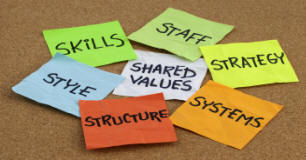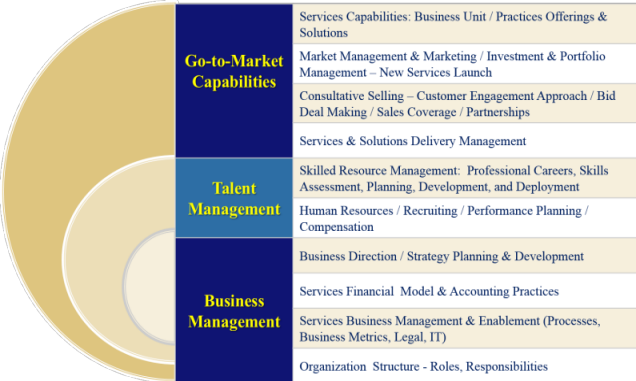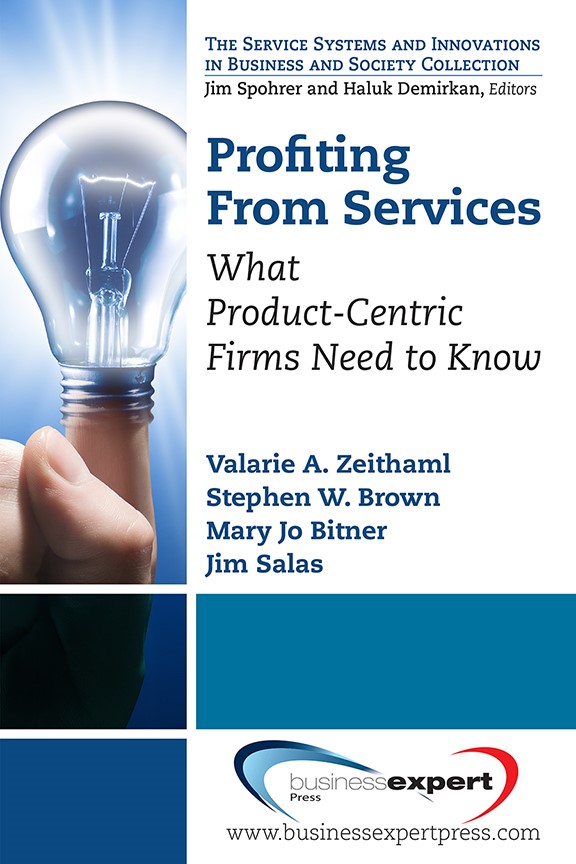Insight's Cultural Challenge Series
#5 - Skilled Resources Management
September 2015
by Bob Giacometti, Managing Partner, The Insight Group
The following article is one of a multi-part series on cultural challenges, utilizing The INSIGHT Group's 10 Elements under its Solutions / Services Business Model Architecture. The series' full introduction is reprinted below, but you can jump to this article's specific element #5 - Skilled Resources Management by clicking here.
 Introduction
Introduction
As more product focused firms adopt an accelerated growth strategy using fee-based services & solutions, the number one inhibitor to profitable growth with high customer satisfaction is the desire to maintain their existing “product driven” business model, culture, and business processes. The essence of a successful services business centers on two principles:
|
The key to executing these principles is not to sub-optimize either the services or product businesses, but to maximize shared assets, intellectual capital and expertise.
Critical to the success of installing / operating a services business model is the ability to establish a customer-centric business culture and supporting services business processes.
Culture Definition
Culture can be viewed as a system of shared beliefs, values, customs and behaviors, that the members of the company use to relate to their customers and with one another; these are transmitted from generation to generation through learning.
Peter Drucker (The Theory of the Business) sees business culture as the legacy behavior patterns that result from the previous successful business strategy / model. The longer the success, the more difficult it is to change; or even to remember why we do these things and behave this way.
A new business strategy / model requires changing / evolving your culture in order to execute it. In fact culture is the critical success factor in execution.
Services / Solutions Business Model Architecture
The Services / Solutions Business Model Architecture has ten design elements covering Go-To-Market Capabilities, Talent Management, and Business Management. Our experience has found that the existing culture is many times the largest barrier that the organization / leadership have in making the shift to this new model.
This series will examine the ten elements and point out some of the cultural challenges that can get in the way of making the change. For a more detailed description on each of the ten elements of INSIGHT's Solutions & Services Business Model Architecture, see the INSIGHT White Paper, Transforming into a Customer Solutions Business.
The Solutions & Services Business Model Architecture

Let’s discuss the impact of culture on Design Element #5: “Skilled Resource Management”
Service Business Model Element #5:
"Skilled Resources Management"
Professional Careers, Skills Assessment, Planning, Development, and Deployment (Access to Expertise / Capabilities)
What is Skilled Resources Management?
An important part of INSIGHT’s Services / Solutions Business Model (SBM) Architecture is the continual acquisition, development, and rapid deployment of “customer valued skills” for developing and delivering profitable services and solutions to solve client problems. A strategic “end-to-end” Skilled Resources Management (SRM) process is a key component of the INSIGHT SBM architecture. SRM enables services organizations to improve their business results and those of their clients as it helps to:
|
The SRM process requires tight integration with the strategic business planning cycle, services marketing, sales, delivery, skills and profession and development, and business support teams such as HR, Finance and IT.

As shown in the model above, the key SRM elements include:
|
The Impact of Culture in Skilled Resources Management
There are certain key elements which help to further enable an effective SRM process for delivering “customer value” through the talents of your people. As outlined in our Culture Challenge series, Culture plays a key role in every services organization and getting it right can be a differentiator for success. While our focus here is on Culture’s impact on Skilled Resources Management, you can download the full Insight White Paper, Seven “C’s” for Success in Professional Services, at the bottom of this page to explore the other six “C’s”.
Culture
Beyond the basic beliefs and values of the organization, the services culture is primarily driven by client wants, needs, and preferences and is characterized by collaboration, teaming, shared learning, customer valued skills, adaptability, devolved decision making, dynamic resource allocation, accountability, desired behaviors and results, and shared success. It is an achievement focused culture that rewards individuals and teams for designing and delivering profitable services and solution offerings, meeting or exceeding client expectations, and for improving customer satisfaction and loyalty.
Organizations such as IBM, HP, Xerox, and others continually seek ways to prioritize, balance, and embrace diverse organizational cultures, strategies and structures, as the old and new units compete for the organization’s limited people and financial resources - while advancing the interests of customers.
With the right culture in place, you can better prioritize and align allocation of investment and organizational support, minimize competition, and maximize shared resources. This is especially important in product companies moving toward more services and solutions offerings. An effective SRM process allows services organizations to continually assess their ongoing capacity to meet planned “high probability” opportunities in the strategic services business plan and help to insure success in services.
| 2. “Solutions & Services Business Model Architecture Graphic” Intellectual Capital owned by The INSIGHT Group |
|
|
|
||
| Download White Paper | Download White Paper | ||
| "Skilled Resources Management" | "Transforming into a Customer Solutions Business" |
If you would like more information on this topic, contact Bob Giacometti (giaco@insight-group.com )

|
Bob Giacometti has extensive “hands on” HR leadership experience designing and implementing new HR initiatives for highly successful services companies. Bob was the HR Executive for IBM Global Services and held key leadership roles during a 32 year IBM career. He was Vice President, National Action Council for Minorities in Engineering, and Vice President for Human and Financial Resources at the Rockefeller Foundation. Bob leads INSIGHT’s HR/Talent Management Practice. More on Bob at INSIGHT |
The INSIGHT Group is a management consulting firm dedicated to assisting product-based companies implement high growth services and solutions business plans and strategies. We help clients design and execute broad transformational initiatives including go to market strategies as they extend their product portfolio to include delivering capabilities as a service. Our partners are experienced line executives with a proven track record of helping our clients transform from a product-focused company to services and solutions led company.
 |
 |
 |
| Meet our Clients | Meet our Thought Leaders | Meet our AlliancePartners |














